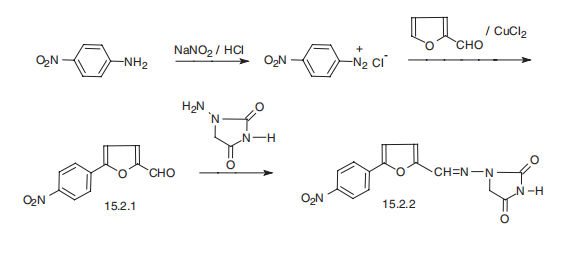|
| | DANTROLENE Basic information |
| Product Name: | DANTROLENE | | Synonyms: | DANTROLENE;DANTROLENE FREE BASE (FOR R&D ONLY);Dantrolene free base;DANTROLENE USP/EP/BP;2,4-Imidazolidinedione,1-[[[4-(4-nitrophenyl)-2-furanyl]meth... | | CAS: | 85008-71-5 | | MF: | C14H10N4O5 | | MW: | 314.25 | | EINECS: | | | Product Categories: | | | Mol File: | 85008-71-5.mol |  |
| | DANTROLENE Chemical Properties |
| Melting point | >236°C (dec.) | | density | 1.57±0.1 g/cm3(Predicted) | | storage temp. | Hygroscopic, Refrigerator, under inert atmosphere | | solubility | DMSO (Slightly), Methanol (Very Slightly, Sonicated) | | form | Solid | | pka | pKa 7.5 (Uncertain) | | color | Yellow to Dark Yellow | | Stability: | Hygroscopic |
| | DANTROLENE Usage And Synthesis |
| Description | Dantrolene is a drug that causes spastic muscle contraction. Unlike other muscle relaxants,
it has a direct effect on the contractile mechanism by interfering in the process of calcium
ion release from the sarcoplasmic reticulum. This results in a lack of coordination in the
mechanism of excitation––contraction of skeletal muscle, which has a greater effect on
fast muscle fibers than on slow muscle fibers. | | Uses | Relaxant (skeletal muscle). | | Uses | Dantrolene is used for controlling the onset
of clinical spasticity resulting from serious clinical cases such as wounds, paralysis, cerebral
palsy, and disseminated sclerosis. Synonyms of this drug are dantrium and danlen. | | Biological Functions | The site of action of dantrolene is believed to be at the sarcoplasmic reticulum in skeletal muscle
cells. Dantrolene binds to a calcium channel protein (ryanodine receptor) on the sarcoplasmic
reticulum to close the channel and inhibit the release of calcium; the alkaloid ryanodine activates
the same receptor to open the channel. | | Mechanism of action | Dantrolene is believed to act directly on the contractile
mechanism of skeletal muscle to decrease the force of contraction in the absence of any
demonstrated effects on neural pathways, on the neuromuscular junction, or on the excitable
properties of the muscle fiber membranes. Cardiac muscle and smooth muscle are minimally
affected by dantrolene, likely because calcium release from sarcoplasmic reticulum of these
muscle cell types occurs via a mechanism that differs from skeletal muscle. The muscle relaxant
effect of dantrolene on skeletal muscle, however, is not specific, and generalized muscle
weakness occurs as a major adverse side effect. Like other hydantoins, dantrolene is a weak
base (pKa = 7.5) that can cross the blood-brain barrier; thus, CNS depressant side effects (e.g.,
sedation) are common. Dantrolene sodium salt is slowly absorbed from the gastrointestinal tract.
The mean half-life of the drug in adults is approximately 9 hours after a 100-mg dose. It is slowly
metabolized by the liver to give the 5-hydroxy and acetamido (nitro reduction and acetylation)
metabolites, as well as unchanged drug, excreted in the urine. | | Clinical Use | Dantrolene is a hydantoin derivative that acts peripherally to reduce spasticity and is indicated
for use in spinal cord injury, stroke, cerebral palsy, and multiple sclerosis. | | Synthesis | Dantrolene, 1-[[[5-(4-nitrophenyl)-2-furanyl]methylene]amino]-2,4-imidazolidinedione
(15.2.2), is synthesized by reacting 4-nitrophenyldiazonium chloride with furfurol,
forming 5-(4-nitrophenyl)-2-furancarboxaldehyde (15.2.1), which is reacted further
with 1-aminohydantoin, to give the corresponding hydrazone, dantrolene (15.2.2). 
|
| | DANTROLENE Preparation Products And Raw materials |
|